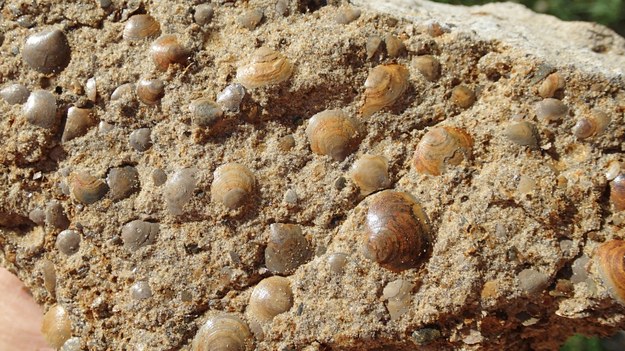The story of evolution written in phosphorus
 Phosphatic shells in the uppermost Cambrian sandstone from Estonia. Photo by M. Mergl.
Phosphatic shells in the uppermost Cambrian sandstone from Estonia. Photo by M. Mergl.
In a comprehensive study of interesting but still little known Devonian fossils with phosphatic shells from the Prague Basin in the Czech Republic, two Czech palaeontologists, Petr Kraft and Michal Mergl, discussed their occurrences in the geological past. These were mostly well-known facts, including the gradual decline that culminated at the end of the Early Paleozoic during the Devonian. However, they also noted that some groups represented in the older strata by large specimens produced dwarf forms in the Devonian. It's as if they're lacking the material for shells. The logical question was asked - why?
M. Mergl laconically remarked that "phosphorus was stolen by vertebrates". This remark actually became the "starting shot". The question of the radical loss of phosphorus in the environment proved so exciting that both authors set about studying in detail the various corners of the cycle of this element. This by-product of the original study thus grew into an independent research. And by a fortunate constellation, it also offered one of the answers to a project currently being under the study by the senior author that was not originally related to phosphorus research at all - unexpected connections are the spice of research...
"The phosphorus cycle is one of the fundamental elemental cycles that, among other things, play a key role in the biology of oceans. Therefore, there is a number of studies on it. The problem, however, is that the vast majority of them investigate the phosphorus cycle of the "human era", which has significantly changed the whole cycle. Therefore, we decided to offer a synthetic model of the phosphorus-influenced evolutionary story for publication," explains one of the co-authors, Ass. Prof. Petr Kraft from the Institute of Geology and Paleontology, Faculty of Science, Charles University, Prague. Published studies clearly show that the availability of phosphorus in the environment sets a clear limit for the expansion of life. And since the availability of this element can influence both short-term and long-term processes, the authors decided to discuss the role of phosphorus in three phases of the evolution of life in the oceans.
The first stage is the late Precambrian (Ediacaran Period), characterized by easy availability of phosphorus and numerous phosphate accumulations. Combined with an increase in oxygen content, it can be considered one of the key causes of the emergence of multicellular organisms.
The Early Paleozoic was a critical era of phosphorus cycle due to the intense involvement of biota in its dynamics. At the beginning, phosphorus was easily available in great amount and therefore many groups had the opportunity to build external phosphatic shells. This very likely contributed to the story of the Cambrian explosion, a period when representatives of almost all animal phyla appeared in the fossil record within a relatively short period of time. The Cambrian was thus a "golden age" for organisms with external phosphatic shells.
 Phosphatic shell of the discinid brachiopod Chynithele amoena from the Middle Devonian (Eifelian) limestone from the Czech Republic. Photo by M. Mergl
Phosphatic shell of the discinid brachiopod Chynithele amoena from the Middle Devonian (Eifelian) limestone from the Czech Republic. Photo by M. Mergl
During the Ordovician Period, however, life began to change significantly, with the so-called Great Ordovician Biodiversification Event (GOBE) greatly expanding both the numbers of taxa and individuals. The main use of phosphorus shifted: it was needed in cell structures and external phosphate shells began to become a luxury. This process has been accelerated by the emergence and evolutionary diversification of vertebrates, which, although they need a lot of phosphorus, are better at managing it. This second evolutionary phase culminated in the vertebrate explosion during the Devonian nekton revolution and marked the decline of groups with external phosphate shells.
The subsequent era from the end of the Paleozoic to the present is characterized by limited but also selective availability of phosphorus in the seas and oceans. Geological processes such as the Variscan (400-300 Ma) and the Alpine orogenies (80 Ma to the present) have greatly aided the supply of phosphorus to the oceans. However, the ability of phosphorus to reach the oceans from its main source in the rocks of the denuded continents was hampered by the spreading of vegetation on land and other influences such as climate during this times. Most importantly, it is concentrated in organisms in the water column. And pelagic vertebrates are the main "filter". "It is very interesting that fluctuations in phosphorus availability in the post-Devonian periods affected linguliform brachiopods, which not only managed to survive with an external phosphate shell, but also recorded a temporary recovery during the Tertiary," explains the junior author of the study, Professor Michal Mergl from the Faculty of Education of the University of West Bohemia in Pilsen.
Original paper:
Petr Kraft, Michal Mergl, Struggle for phosphorus and the Devonian overturn, Trends in Ecology & Evolution, Volume 37, Issue 8, 2022, Pages 645-654, ISSN 0169-5347, https://doi.org/10.1016/j.tree.2022.03.009.
Document Actions